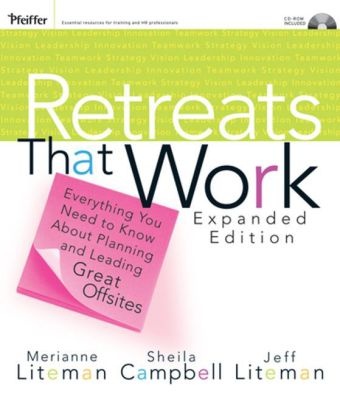En savoir plus
This is really two books in one, The Facilitator's Guide section, targets the needs of those who design and facilitate retreats. Contains dozens of new exercises, augmented facilitation techniques, new case studies, and enhanced guidance on troubleshooting, design, and planning.
Table des matières
CD Contents.
Acknowledgments.
Introduction.
SECTION ONE: Materials for the Facilitator.
Chapter 1: Working with the Client.
Nine Reasons to Hold a Retreat.
Ten Reasons Not to Hold a Retreat.
What If the Client Is Your Boss?
Aligning Yourself with the Client.
Kinds of Retreats.
Using a Specialized Retreat Format.
Chapter 2: Planning the Retreat.
Pre-Retreat Interviews with Participants.
Identifying the Scope of Issues and Creating the Retreat Plan.
Who's Who in Planning a Retreat.
Involving Participants in Retreat Planning.
Deciding Whether to Work with a Co-Facilitator.
Thinking About Logistics.
Creating the Conditions for Success.
Chapter 3: Retreat Design Issues.
Sins of Omission: The Top Retreat Design Mistakes.
Prework for Retreat Participants.
Using White Space.
Capturing the Work Product.
Design Issues for a Series of Retreats.
Chapter 4: Retreat Design Components.
Introduction.
Ground Rules or Norms.
Individual Check-In.
Reporting Your Findings.
Content Segments.
Decision Making.
Action Planning.
Closing.
Post-Retreat Follow-Up.
The Importance of Timing.
Chapter 5: Structuring the Retreat.
Group Size and Composition.
Varying the Methodologies.
Incorporating Rituals.
Chapter 6: Leading the Retreat.
Key Facilitation Practices.
Encouraging Participation.
Process or Content Facilitator?
When Should the Facilitator Intervene?
Giving Feedback to Retreat Participants.
Co-Facilitation Challenges.
Diversity Issues.
Recording the Group s Work.
Monitoring the Group s Energy.
Changing the Plan.
Chapter 7: How to Recover When Things Go Awry.
A Few Participants Dominate the Discussions.
The Group Keeps Wandering off Task.
The Group's Energy Is Flagging.
A Participant Keeps Plowing the Same Ground.
A Participant Repeatedly Disrupts the Conversations.
The Participants Refuse to Deal with Important Issues.
A Senior Manager Violates the Ground Rules.
People Are Misusing Humor.
A Participant Is Overtly Hostile or Refuses to Participate.
"I'm Outta Here": A Participant Walks Out.
A Participant Gets Furious or Defensive or Bursts into Tears.
Participants Are Turning the Retreat into a Gripe Session.
Participants Are Resisting New Ideas.
Activity: Gains and Losses.
An Intense Conflict Breaks Out.
A Participant Breaches Another's Confidence.
The Group Is Resisting You.
Chapter 8: Helping Participants Make Decisions and Plan for Action.
Methods of Decision Making.
Activity: Let's Take Our Chances.
Types of Retreat Decisions.
Activity: Our Stable of Clients or Resources.
Activity: Rating Resources.
Activity: Criteria Evaluation Grid.
Activity: Show Me Our Future.
The Nub: Action Planning.
Chapter 9: Leading a Strategic Planning Retreat.
Why Strategic Planning?
Elements of Organization Strategy.
Activity: Exploring Strategic Direction.
Activity: Prioritizing Constituencies.
Activity: Distinctive Competencies.
Activity: Our "Proverbial" Differentiation.
Activity: Sell Me Glamour.
Activity: Centers of Excellence.
Discerning the Organization's Values.
Activity: Values Vignettes.
Activity: Values Auction.
Understanding the Environment.
Activity: Glimpses into the Future.
Activity: Alternative Futures.
Evaluating Work Processes.
Planning for Action.
Activity: Targeting Results.
Checking Against Resources.
Activity: Resource/Impact Matrix.
Devising Strategies.
Testing Strategies.
Activity: Obstacle Busters I.
Writing the Plan 247
Chapter 10: Leading a Culture Change Retreat.
Great Expectations: What Can Realistically Be Accomplished at a Retreat.
Activity: Visit Our Village.
Activity: How We Behave.
Activity: Timeline of Our History.
Activity: Significant Stories.
Working with Sensitive or Controversial Issues.
Activity: Silent Dial

